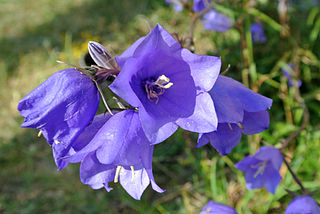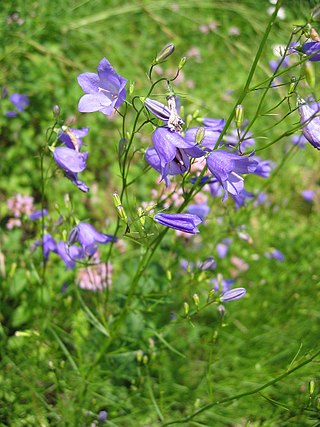
Campanula is the type genus of the Campanulaceae family of flowering plants. Campanula are commonly known as bellflowers and take both their common and scientific names from the bell-shaped flowers—campanula is Latin for "little bell".

Campanula rotundifolia, the common harebell, Scottish bluebell, or bluebell of Scotland, is a species of flowering plant in the bellflower family Campanulaceae. This herbaceous perennial is found throughout the temperate regions of the northern hemisphere. In Scotland, it is often known simply as bluebell. It is the floral emblem of Sweden where it is known as small bluebell. It produces its violet-blue, bell-shaped flowers in late summer and autumn.

Campanula americana, the American bellflower, or tall bellflower, is a bellflower native to eastern North America. Tall bellflowers can be annual or biennial with a varying life-history with seeds germinating in the fall producing annual plants and spring-germinating seeds producing biennial plants. Long-tongued bees are the primary pollinators, including Megachile campanulae, but halictid bees, butterflies, and skippers may also act as pollinators. Tall Bellflowers do not generally self-pollinate. Some authorities, including the USDA PLANTS database, consider the name Campanulastrum americanum to be the accepted name for this species.

Campanula carpatica, the tussock bellflower or Carpathian harebell, is a species of flowering plant in the family Campanulaceae.

Puccinia campanulae is a plant pathogen that causes rust on bellflower (Campanula).

Campanula rapunculoides, known by the common names creeping bellflower, rampion bellflower, rover bellflower, garden bluebell, creeping bluebell, purple bell, garden harebell, and creeping campanula, is a perennial herbaceous plant of the genus Campanula, belonging to the family Campanulaceae. Native to central and southern Europe and west Asia, in some parts of North America it is an extremely invasive species.

Campanula gelida is a stenoendemic, critically endangered species of flowering plant in the bellflower family Campanulaceae. It is a perennial species that grows in the mountains of Hrubý Jeseník in the Czech Republic. It evolved through specialization of an isolated population of Campanula scheuchzeri, an Alpine species, which expanded to the area of the Sudetes during a colder period, probably the last ice age. It is closely related to Campanula bohemica, endemic to the Giant Mountains. Sometimes it is even considered its subspecies and referred to as Campanula bohemica subsp. gelida. They all belong to the group of related species Campanula rotundifolia agg.

Salix lanata, the woolly willow, is a subarctic species of willow native to Iceland, the Faeroe Islands and Finland, through to eastern Siberia. In Scotland it can be found in only a few localities of Perthshire, Angus and Aberdeenshire, generally on rocky mountain sides at altitudes of 600–900 m (1,969–2,953 ft).

Krascheninnikovia lanata is a species of flowering plant in the family Amaranthaceae, known by the common name winterfat. It is native to much of western North America: from central Western Canada; through the Western United States; to northern Mexico.
Eastwoodiella californica is a species of flowering plant in the bellflower family Campanulaceae, known by the common names swamp bellflower and swamp harebell. It is the sole species in genus Eastwoodiella.

Campanula scouleri is a species of bellflower known by the common names pale bellflower and Scouler's harebell. It is native to the mountains of western North America from northern California to Alaska.

Campanula shetleri is a rare species of bellflower known by the common name Castle Crags bellflower. The plant is named for Castle Crags, a mountain formation in its limited native range, within the Shasta-Trinity National Forest.

Campanula portenschlagiana, the wall bellflower, is a species of flowering plant in the family Campanulaceae, native to the Dalmatian Mountains in Croatia. It is a vigorous, low-growing, mound-forming evergreen perennial with deep purple flowers in summer. Other common names include Dalmatian bellflower, Adria bellflower and Campanula muralis.

Campanula alliariifolia is a species of flowering plant in the bellflower family Campanulaceae. It is native to the Caucasus and Turkey and it is grown as an ornamental plant. Common names include Cornish bellflower.

Campanula uniflora, known commonly as arctic bellflower and arctic harebell, is a short and slender rhizomatous perennial in the bellflower family Campanulaceae. It is distributed in arctic North America, including the Rocky Mountains and Greenland, in the Asian part of Beringia and in Iceland, Svalbard, the Scandes Mountains and Novaja Zemlja.

Campanula robinsiae is a rare species of flowering plant in the bellflower family known by the common names Brooksville bellflower, Robins' bellflower, and Chinsegut bellflower. It is endemic to Florida, where it is known from four or five occurrences in Hernando and Hillsborough Counties. Its population has fluctuated throughout the years; at one point in the early 1980s it was feared extinct. Today there are two populations in Hernando County and probably three in Hillsborough River State Park. At the time the plant was listed as an endangered species of the United States in 1989, it was known from three small populations on wet prairies that were threatened by changes in the local hydrology and by pollution. It was also thought to be threatened by vandalism, trampling, and collecting by flower enthusiasts. Cattle grazing and invasion of the habitat by the exotic skunkvine also degrade the habitat.

Campanula cochleariifolia, common name earleaf bellflower or fairy's-thimble, is a species of flowering plant in the family Campanulaceae, native to the Pyrenees, Alps, French Massif Central, and Carpathian Mountains of Central Europe. It is a rhizomatous herbaceous perennial growing to 10 cm (4 in). Clumps of bright green leaves produce nodding pale blue bell flowers on wiry stalks. It is often found growing on limestone.

Campanula piperi is a species of flowering plant in the bellflower family, Campanulaceae. It is native to the Olympic Mountains on the Olympic Peninsula in the U.S. state of Washington. It has also been noted on Vancouver Island, British Columbia.
Campanula kantschavelii, also known as Kanchaveli's bellflower, is a species of flowering plant in the family Campanulaceae. It is native to Georgia.
Campanula seraglio, known as the Serail bellflower, is a species of flowering plant in the family Campanulaceae. It is native to northeastern Turkey.


















